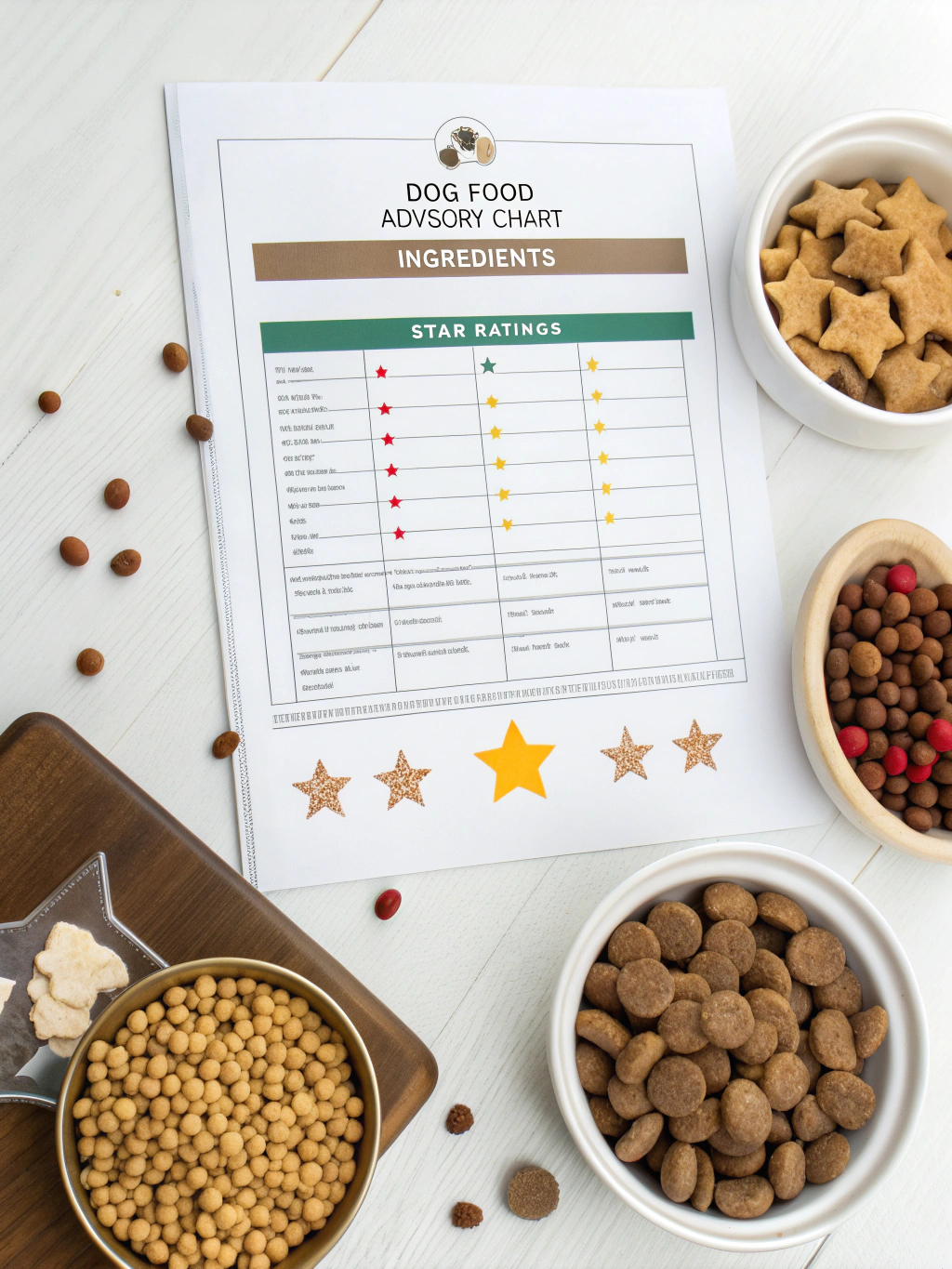The 2025 Dog Food Advisor Ratings: Top Rated & Avoided Brands
Table of Contents
Introduction
Have you ever stood in the dog food aisle, feeling overwhelmed by the sheer number of options? With so many brands claiming to be the best, how do you know which one truly delivers for your furry friend? That’s where the importance of dog food advisor ratings comes into play. Reputable reviews, such as those from the Dog Food Advisor, provide invaluable insights into the quality, safety, and nutritional value of different dog food brands.
In this article, we’ll dive into the Dog Food Advisor’s ratings for 2025, highlighting the top-rated brands you can trust and the ones to avoid. We’ll also explore the criteria that make a dog food brand stand out from the crowd. Whether you’re a new dog owner or simply looking to switch up your pup’s diet, this guide will help you navigate the overwhelming world of dog nutrition with ease and confidence.
Ingredients List
Just like any recipe, selecting the right ingredients is crucial when it comes to dog food. Below, we’ll outline the key ingredients to look for in a high-quality dog food and suggest some beneficial substitutions.
- High-Quality Protein Sources – Ingredients like chicken, beef, fish, or lamb should be listed first in the ingredient panel. These provide the necessary amino acids for your dog’s muscle development and overall health.
- Whole Grains or Veggies – Options like brown rice, sweet potatoes, or peas serve as excellent carbohydrate sources for sustained energy.
- Healthy Fats – Ingredients such as flaxseed, fish oil, or chicken fat contribute to a shiny coat, healthy skin, and proper brain function.
- Vitamins and Minerals – Look for natural sources like carrots, spinach, or supplemented nutrients that ensure a well-rounded diet.
Potential Substitutions: If your dog has a sensitivity to certain proteins, consider a grain-free formula with alternative proteins like turkey, venison, or duck. For dogs with grain allergies, opt for grain-free options that use potato or pea protein instead.

Timing
Prepping for the right dog food might not take physical time, but considering the lifespan of a quality dog food product is essential. Here’s a quick timeline:
- Researching Brands (Approx. 1-2 hours): This includes reading reviews, such as the dog food advisor ratings, comparing ingredients, and checking for certifications.
- Transitioning Food (Gradual 7-10 days): Introduce the new food slowly to avoid upsetting your dog’s stomach. Mix it with their current food and gradually increase the proportion.
- Ongoing Observation ( Lifelong): Once you’ve chosen a food, monitor your dog’s health, appetite, and energy levels. Adjust as needed over time.
Interestingly, investing a bit more time upfront in researching dog foods can lead to better health outcomes for your pet, potentially reducing long-term vet bills.
Step-by-Step Instructions
Step 1: Research Dog Food Brands
Start by exploring reputable sources. Make it a habit to check the dog food advisor ratings and look into dog food brand reviews 2025 to stay informed.
Step 2: Analyze Ingredient Composition
Once you have a shortlist of brands, scrutinize their ingredient list. A high-quality dog food should list a primary source of animal-based protein first, followed by whole grains or vegetables, and fatty acids.
Tip: Always check for any fillers or artificial additives which can be detrimental to your dog’s health.
Step 3: Consider Your Dog’s Specific Needs
Older dogs, puppies, or those with specific health issues may require tailored diets. For instance, senior dogs might benefit from lower calorie counts to match their lower activity levels. Meanwhile, puppies need higher levels of protein and fat to support their rapid growth.
Step 4: Consult with Your Veterinarian
It’s often a smart idea to consult with your veterinarian before making any significant changes to your dog’s diet. They can provide personalized recommendations based on your dog’s breed, age, weight, and health conditions.
Step 5: Make a Decision and Monitor
Choose the dog food that best fits your dog’s nutritional needs and start reintroducing it slowly. Keep a close watch on how your dog adapts to the new food. Look for improvements in coat quality, energy levels, and overall demeanor.
Don’t hesitate to try another brand if issues arise. Remember, the best dog food for your pet is one that is nutritionally complete, safe, and tailored to their unique needs.
Nutritional Information
When evaluating dog food, understanding the nutritional content is paramount. Here’s a quick guide to help you read the nutritional labels:
- Protein Content: Essential for muscle development, look for a minimum of 18% protein in adult dog foods.
- Fat Content: A source of essential fatty acids, healthy fats should constitute at least 5% of the total content for active breeds.
- Fiber Content: Aids in digestion – around 2-4% is generally ideal. Too much, and it can cause issues.
- Added Vitamins and Minerals: Ensure the food is enriched with necessary nutrients unless you are feeding a tailor-made raw diet.
Most dog foods come with a guaranteed analysis, detailing the minimum levels of crude protein and fat and maximum levels of fiber and moisture. Always aim for balanced nutrients that align with your dog’s age, activity level, and health condition.
Healthier Alternatives for the Recipe
Even top-rated brands can sometimes lack certain elements or contain ingredients that don’t suit your dog. Here are some alternatives to consider:
- Homemade Meals: If feasible, consult a veterinary nutritionist to create a balanced home-cooked diet for your dog.
- Fresh Food Subscription Services: Companies like Freshpet or NomNomNow provide fresh, human-grade meals tailored to your dog’s needs.
- Supplementing Kibble: Enhance a store-bought kibble diet with fresh ingredients like plain pumpkin, steamed carrots, or a bit of cooked chicken to upscale the nutritional value.
While convenience is key for many pet owners, considering these alternatives can provide additional nutritional benefits to your dog’s diet. Always make sure any additions to your dog’s diet are vet-approved, especially when seeking healthier dog food brands.
Serving Suggestions
Transitioning to a new dog food should be seamless and stress-free. Here’s how to make the switch smoothly:
- Start by mixing a small portion of the new food with the old, gradually increasing the new food’s proportion over a week.
- Serve the food at room temperature; warm canned food slightly for a more enticing aroma.
- Use slow feeder bowls for dogs that tend to gulp their food, which can help digestion and prevent obesity.
A little preparation can go a long way in ensuring your dog enjoys their meals and adapts to the new food without any fuss.
Common Mistakes to Avoid
Navigating the world of dog nutrition can be tricky, but avoiding these common mistakes can help ensure your pet’s dietary needs are met:
- Ignoring the Ingredient Quality: Don’t just look at the price; the quality of the ingredients is what truly matters.
- Suddenly Switching Foods: Abrupt diet changes can cause digestion problems for your dog.
- Not Considering Dietary Needs: Puppies, seniors, and dogs with health issues have different nutritional requirements.
- Skipping Veterinary Advice: It’s always best to get professional opinions before making significant changes to your dog’s diet.
By staying aware and informed, you can save your dog from unnecessary discomfort and yourself from potential nutritional oversights.
Storing Tips for the Recipe
Proper storage ensures that the premium quality of your dog’s food is not compromised:
- Seal Tightly: Once opened, keep the bag tightly sealed to maintain freshness.
- Store in a Cool, Dry Place: Heat and moisture can spoil dog food. Ideal storage is in a pantry or cupboard.
- Measure Correctly: Use a measuring cup to ensure accurate feeding amounts which is part of maintaining optimal health.
Taking these simple steps can make a big difference in preserving the nutritional quality and shelf-life of your dog’s food.
Conclusion
Choosing the right dog food is one of the most critical decisions you’ll make as a pet owner. Reading expert reviews, like the dog food advisor ratings, and considering dog food brand reviews 2025 are excellent starting points for navigating the overwhelming range of products available.
Always remember the unique needs of your furry companion. Whether your dog is a young pup, a playful adult, or a calm senior, their nutritional requirements will differ. By prioritizing quality, ingredients, and your dog’s health status, you’re on the right path to ensuring they live a happy, healthy life.
Now that you’re equipped with this detailed guide, why not explore more about dog nutrition or share this with a fellow pet enthusiast? Your thoughtful choice today can greatly impact your dog’s life at home in the years to come.
FAQs
Q1: How often are the Dog Food Advisor ratings updated?
The ratings are updated regularly, often with new reviews and insights released monthly. You can stay updated by visiting the link here.
Q2: What are the signs that my dog’s food isn’t right for them?
Look for symptoms like frequent diarrhea, upset stomach, lethargy, or excessive shedding. These can be indicators that the food needs to be altered. Consult with your vet for guidance.
Q3: Can I feed my dog home-cooked meals regularly?
While home-cooked meals can be nutritious, they need to be balanced to meet all of your dog’s dietary requirements. A better approach is to consult with a veterinary nutritionist to ensure that your pet’s diet is complementary and nutritionally sound. Ensure the ingredients align with the principles of a balanced, whole-food diet like those highlighted in the dog food advisor ratings.
Q4: Are organic dog foods better?
Organic foods free from pesticides, synthetic fertilizers, or genetically modified organisms are often considered healthier. However, the best food depends on your dog’s unique needs. Always choose foods that are nutritionally balanced, regardless of them being organic.
By keeping these insights in mind, you’ll be well on your way to providing the best possible nutrition for your beloved pet.



